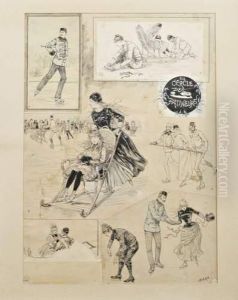Maurice Bonvoisin Paintings
Maurice Bonvoisin, known by the pseudonym Mars, was a French illustrator and caricaturist born on July 31, 1849, in Verviers, Belgium. Although he was born in Belgium, his family moved to France, and he became deeply integrated into the French art scene. Bonvoisin is often remembered for his contributions to the world of satirical illustration during the late 19th and early 20th centuries.
Mars started his artistic education at the École des Beaux-Arts in Paris, where he studied under the tutelage of artists such as Isidore Pils and Henri Lehmann. He began his artistic career as an illustrator, contributing to various newspapers and periodicals. His work appeared in well-known publications such as 'Le Charivari', 'Le Monde Illustré', 'L’Illustration', and 'Le Rire', among others. He was known for his sharp wit and ability to encapsulate the peculiarities of French society in his images.
Throughout his career, Bonvoisin worked on a variety of projects, including book illustrations, posters, and theatrical scenery. He became well-known for his caricatures of public figures, which were not only humorous but also often carried a poignant critique of political and social issues of the day. His style was characterized by a keen eye for detail, a deft hand at capturing likenesses, and a playful approach to exaggeration and satire.
Maurice Bonvoisin's work is a valuable historical record of the society and politics of his time. Despite the humorous nature of his illustrations, they provide insight into the cultural and social dynamics of France during the Belle Époque. Bonvoisin's legacy as an illustrator and caricaturist is marked by his ability to blend artistry with commentary, a tradition that continues to influence satirical artists today.
Mars died on October 4, 1912, in Paris. His body of work has been preserved and is studied by art historians and enthusiasts who are interested in the evolution of caricature and illustration in the context of French art history. Maurice Bonvoisin's contributions to the art world remain significant for their historical value and their enduring wit and charm.
